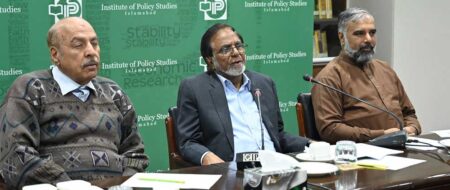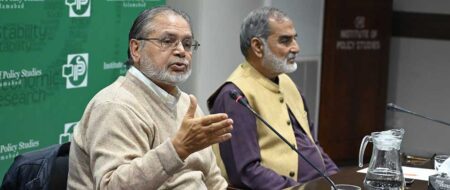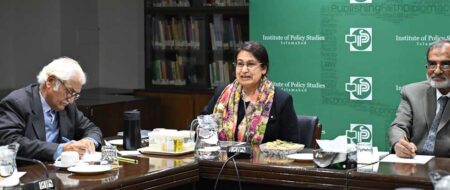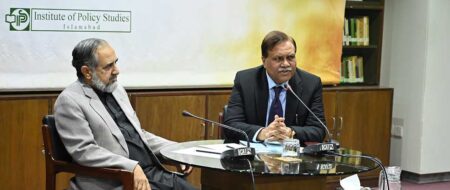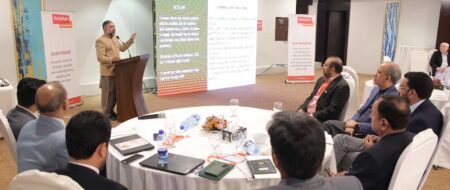CPEC Opportunities and Impediments: Prospects for Business Community
Pakistani businesses must invest in R&D for integration into new global value chains
Pakistan’s business community should prepare itself to be part of CPEC-connecting new international value chains and invest in research and development to enhance its capacity to meet the challenges and reap the opportunities the Chinese initiative was set to create in the near future.
 This was the crux of a seminar held at IPS on August 26, 2016, titled “CPEC Opportunities and Impediments: Prospects for Business Community”, which was addressed by Zaheeruddin Dar, CBI Expert &Trainer, Centre for International Entrepreneurship and Trade as the key speaker while Saeed Qureshi, former federal secretary, chaired the session.
This was the crux of a seminar held at IPS on August 26, 2016, titled “CPEC Opportunities and Impediments: Prospects for Business Community”, which was addressed by Zaheeruddin Dar, CBI Expert &Trainer, Centre for International Entrepreneurship and Trade as the key speaker while Saeed Qureshi, former federal secretary, chaired the session.
Advising the traders and industrialists to augment their production competency by improving their research-based design and development, Dar urged the business owners to must realize the potential associated with CPEC, which was the most important of the six components of the greater ‘One Belt One Road (OBOR)’ initiative of China.
He emphasized that the business community in Pakistan should proactively build its capacity to ride upon the immense opportunities coming up with CPEC, which despite being a very big initiative itself, should not be looked in isolation, but in line with its other sister components which include the 21st Century Maritime Silk Route, Bangladesh-China-India-Myanmar Economic Corridor, China-Mongolia-Russia Economic Corridor, China-Central Asia-West Asia Economic Corridor (Eurasian Land Bridge) and China-Indochina Peninsula Economic Corridor.
These six components of OBOR, Dar viewed, were set to create a long-lasting effect on the world economy in the future. He maintained that if CPEC was seen as part of the bigger picture of these global initiatives which were aimed at creating the global value chain regionally and internationally, the prospects of growth and expansion for any business increase manifold.
“Only the Maritime Silk Route project comprises development of 17 ports and Gwadar was just one of them”, he explained the scope with an example.
The expert described that with the emergence of OBOR economies – which CPEC is an integral part of – the future will witness removal of investment and trade barriers (FTAs, avoidance of double taxation, and investment protection agreements); customs cooperation and information exchange; mutual recognition of regulations, inspections, quarantine certification and accreditation, standard measurement, statistical information, etc; single window for clearance at entry and exit points; enhanced trade liberalization; lower non-tariff barriers and division of labour and industrial chains, among other developments.
Currency swap agreements, Renminbi as SDR in IMF lending arrangements, bond market in Asia (Renminbi bonds in China), Asia Infrastructure Development Bank, BRICS New Development Bank, SCO financing institutions, Silk Road Fund, China-ASEAN Inter-Bank Association and equity investment funds were the key features of this great Chinese leap, he informed.
Assessing the risks, Dar warned that already a US, EU and Pacific Rim response was building up against the OBOR initiative and there were threats of war and political instability in the recipient countries.
Dar’s proposition was firmly backed by Qureshi who termed China the ‘new economic power house’ and ‘the engine of economic growth’. He said that China’s rapidly growing economy, as per various estimations and reports, is expected to top the rest of the world by 2050 and stay there for a considerable period.
He however found this emerging situation very intriguing given that at a time when the developed countries in the West are increasingly looking inwards, China was opening up and expanding its wings to reach for regional and global alliances.
Advising Pakistan’s business community in light of the given scenario, Qureshi said that the trade and industry in Pakistan should minimize its dependence on the government, and start putting in the hard yards beforehand to prepare itself to avail best of the opportunities when they arrive. Through joint ventures with Chinese businesses we can enhance our capacity, productivity and revenues manifold, he remarked, urging the business community to conduct a comprehensive study about the potential benefits of CPEC to local trade and industry.
China on the other hand, he revealed, had studied this feasibility even for Pakistan well in advance, according to which energy, food, agro-based industry, livestock, construction, steel, transport and logistics, light engineering, plastics, value-added textile, mining and ore, non-ferrous metals, assembly operations and IT services were few of the key sectors in the country that were identified to benefit from CPEC immensely.



